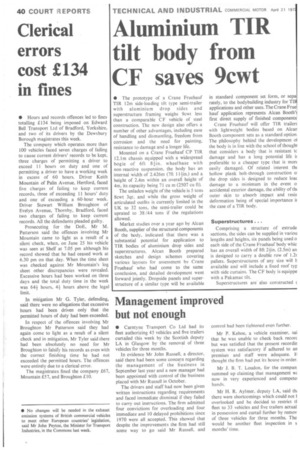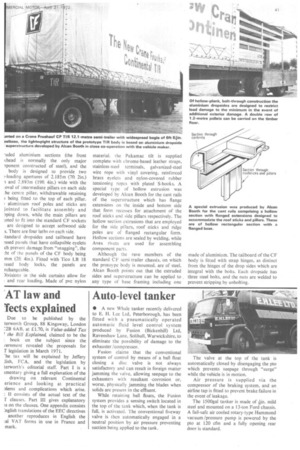Aluminium TIR tilt body from
Page 38

Page 39

If you've noticed an error in this article please click here to report it so we can fix it.
CF saves 9cwt
• The prototype of a Crane Fruehauf TIR 12m side-loading tilt type semi-trailer with aluminium drop sides and superstructure framing weighs 9cwt less than a comparable CF vehicle of steel construction. The new design also offers a number of other advantages, including ease of handling and dismantling, freedom from corrosion and the need for painting, resistance to damage and a longer life.
Mounted on a Crane Fruehauf CP TIR 12.1m chassis equipped with a widespread bogie of 6ft 81-in. wheelbase with non-reactive suspension, the body has an internal width of 2.426m (711 114in.) and a height of 2.4m within an overall height of 4m, its capacity being 71 cu m (2507 cu ft).
The unladen weight of the vehicle is 5 tons 8cwt 3qr, and while the gross weight of articulated outfits is currently limited in the UK to 32 tons, the semi-trailer could be uprated to 38/44 tons if the regulations allowed.
Market studies over a year ago by Alcan Booth, supplier of the structural components of the body, indicated that there was a substantial potential for application to TIR bodies of aluminium drop sides and superstructures. Alcan Booth prepared sketches and design schemes covering various layouts for assessment by Crane Fruehauf who had come to the same conclusion, and detailed development went forward jointly. Dropside panels and superstructure of a similar type will be available in standard component Set form, or sepa rately, to the bodybuilding industry for TI applications and other uses. The Crane Fr hauf application represents Alcan Booth' first direct supply of finished components
Crane Fruehauf will offer TIR trailers with lightweight bodies based on Ale= Booth component sets as a standard option. The philosophy behind the development of the body is in line with the school of thoughl that considers a body that is resistant tc damage and has a long potential life preferable to a cheaper type that is mon easily damaged. Of related interest th( hollow plank bolt-through construction 01 the drop sides is designed to reduce loac damage to a minimum in the event o. accidental exterior damage, the ability of tin outer skin to absorb impact and resis deformation being of special importance is the case of a TIR body.
Superstructures...
Comprising a structure of extrude. sections, the sides can be supplied in variou lengths and heights, six panels being used o each side of the Crane Fruehauf body whic has an overall width of 811 2-1-in. (2.5m) an is designed to carry a double row of 1.2r pallets. Superstructures of any size will b available and will include a fixed roof typ with side curtains. The CF body is equippe with a Pakamac tilt.
Superstructures arealso constructed c -uded aluminium sections (the front thead is normally the only major lponent constructed of steel), and the body is designed to provide two goading apertures of 2.185m (7ft 2in.) .1 and 2.893m (19ft 4in.) wide with the ,oval of intermediate pillars on each side :he centre pillar, withdrawable retaining ; being fitted to the top of each pillar. t aluminium roof poles and sticks are jointed to facilitate assembly and wing down, while the main pillars are ;oted to fit into the standard CF sockets
are designed to accept softwood side s. There are four laths on each side.
;tandard dropsides and tailboard have tssed panels that have collapsible eyelets ch prevent damage from "snagging", the :ht of the panels of the CF body being mm (2ft 4in.). Fitted with Tico LB 18 :ssed body locks, the panels are rchangeable.
hvisions in the side curtains allow for and rear loading. Made of pvc nylon material. the Pakamae tilt is supplied complete with chrome-based leather straps, stainless-steel terminals, galvanized-steel wire rope with vinyl covering, reinforced brass eyelets and nylon-covered rubber tensioning ropes with plated S-hooks. A special type of hollow extrusion was developed by Alcan Booth for the cant rails of the superstructure which has flange extensions on the inside and bottom side that form recesses for attachment of the roof sticks and side pillars respectively. The hollow section extrusions that are employed for the side pillars, roof sticks and ridge poles are of flanged rectangular form. Hollow sections are sealed by welding, while Avex rivets are used for assembling component parts.
Although the rave members of the standard CF semi-trailer chassis, on which the protoype body is mounted, are of steel, Alcan Booth points out that the extruded sides and superstructure can be applied to any type of base framing including one
made of aluminium. The tailboard of the CF body is fitted with strap hinges, as distinct from the hinges of the drop sides which are integral with the bolts. Each dropside has three steel bolts, and the nuts are welded to prevent stripping by unbolting.












































































































